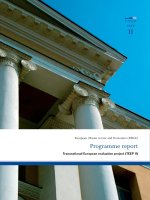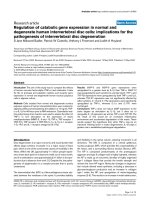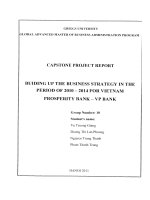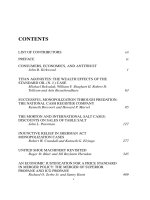MASTER OF ARTS IN LAW AND DIPLOMACY THESIS DEVELOPMENT OF SUPPORTING INDUSTRIES FOR VIETNAM’S INDUSTRIALIZATION: INCREASING POSITIVE VERTICAL EXTERNALITIES THROUGH COLLABORATIVE TRAINING DECEMBER 2005
Bạn đang xem bản rút gọn của tài liệu. Xem và tải ngay bản đầy đủ của tài liệu tại đây (866.22 KB, 96 trang )
Master of Arts in Law and Diplomacy Thesis
Development of Supporting Industries for Vietnam’s
Industrialization:
Increasing Positive Vertical Externalities through Collaborative Training
December 2005
Junichi Mori
The Fletcher School, Tufts University
e-mail:
Junichi MORI / Development of Supporting Industries for Vietnam’s Industrialization
Acknowledgement
This paper is written as my thesis for the Master of Arts in Law and Diplomacy at the
Fletcher School, Tufts University. It compiles my academic work in the Fletcher School
and the research and survey work conducted in the spring and summer of 2004 and the
summer of 2005, when I was a visiting researcher at the Japan-Vietnam Economist Club
(now VDF Tokyo) and the Vietnam Development Forum.
I would like to express my sincere appreciation to Professor Carsten Kowalczyk and
Professor Julie Schaffner for their guidance and support as my thesis advisors at the
Fletcher School. I greatly appreciate that they provided me with economic and policy
analysis skills through classes and many individual tutorials.
Special thanks to Professor Kenichi Ohno of the National Graduate Institute for Policy
Studies and the Vietnam Development Forum, who gave me a lot of valuable advice and
research opportunities in Vietnam.
Special thanks to Professor David Dapice of Tufts University and Harvard University, who
provided me with precious insight into the economic conditions and policy-making
processes in Vietnam.
Thanks to the officials and experts in the Vietnamese and Japanese governments, and
international organizations who provided me with valuable information and perspectives.
Thanks also to all the enterprise managers who provided me with useful information based
on actual business conditions in Vietnam, Malaysia, and Japan.
1
Junichi MORI / Development of Supporting Industries for Vietnam’s Industrialization
Table of Contents
Executive Summary………………………………………………………………..…..….4
1. Introduction……………………………………………………………………..……..6
2. Economic Growth through Development of Supporting Industries……….………7
2.1. Introduction………………………………………………………………………..….……7
2.2. What is Supporting Industry?: Concept and Characteristics………………………….……7
2.3. What is the Role of Supporting Industries in FDI-Driven Growth?.....................................10
2.4. Tradable and Non-Tradable Inputs in MNCs’ Optimum Procurement Strategy…….……..12
2.5. Do Supporting Industries Accelerate the Agglomeration of FDI?........................................14
2.6. Competitive Supporting Industries for the Long-Run Economic Growth…………………16
2.7. Development Paths in Advanced ASEAN Countries, Difficulties in Vietnam…………….18
2.8. Rationales for Policy Intervention: Two Types of Barriers ……………………….….……21
2.9. Differences from “Infant Industry” in Rationale and Primary Target………….……..……23
3. Analyzing Supporting Industries in Vietnam: Possible Policy Recommendations to
Reduce Market Failures…………………………………………………………….25
3.1. Introduction……………………………………………………………………………….25
3.2. MNCs’ Small Demand for Local Procurement of Production Parts………………….…..26
3.3. Supply-Side Constraints: Barriers Which Hinder the Development of Supporting
Industries………………………………………………………………………………….30
3.4. How Can Public Policy Contribute to Removing Obstacles?.............................................33
3.5. Upgrading Technology to Overcome the Minimum Efficient Scale Problem……………34
3.6. Policy Recommendation: Promoting Collaborative Training Programs…………………..41
3.7. Toward More Concrete Policy Proposals………………………………………………….42
4. A Good Practice for Collaborative Training: The Penang Skill Development
Center in Malaysia…………………………………………………………….……44
4.1. Learning from a Good Practice in Malaysia…………………………………………….44
4.2. Establishment of the Penang Skill Development Center………………………………..45
4.3. Structure of PSDC’s Training Programs………………………………………….……..46
4.4. The Global Suppliers Program (GSP): Strengthening Backward linkages……….……..47
4.5. PSDC’s Contribution to the Development of Supporting Industries……………………49
4.6. Primary Factors for PSDC’s Success…………………………………………………....54
4.7. What are MNCs’ Incentives to Participate in PSDC?.......................................................56
4.8. Conditions that MNCs Prefer Collaborative Training Programs……………………...…57
2
Junichi MORI / Development of Supporting Industries for Vietnam’s Industrialization
4.9. Roles of the State and Federal Governments to Support PSDC………………………….62
4.10. Shortcomings of PSDC’s Programs………………………………………………..…….66
4.11. How to Apply Lessons from PSDC in Vietnam…………………………………………67
5. Project Analysis in Vietnam (A): The Project for Strengthening the Training
Capabilities of Technical Workers at Hanoi Industrial College…………….……68
5.1. Introduction……………………………………………………………………….……..68
5.2. Establishment of the HIC-JICA Project…………………………………………….……68
5.3. Structure of Educational Programs in the HIC-JICA Project…………………………….69
5.4.How Does the HIC-JICA Project Contribute to the Development of Supporting
Industries?............................................................................................................................71
5.5. What Attracts MNCs and Domestic Supporting Industries to Participate in the HIC-JICA
project?................................................................................................................................74
5.6. Comparison to PSDC: Collaborative Training in a General Education Program…...........75
5.7. Costs and Benefits for the Involvement of Local Government…………………………...76
6. Project Analysis in Vietnam (B): the Technical Assistance Center Project….…….77
6.1. Introduction………………………………………………………………………………..77
6.2. Establishment of the TAC Project…………………………………………………………77
6.3. Expected Benefits of TAC’s Training Programs……………………………………….….78
6.4. Comparison to PSDC: Lack of Collaborative Training..……………..…………...………78
6.5. Policy Options for Adding Collaborative Training..............................................................79
6.6. Optimal Combination of Vocational Training and General Education……………………80
7. Conclusion…………………………………………………………………….………83
Bibliography………………………………………………………….…………...………86
Annex…………………………………………………………………….……………..…92
3
Junichi MORI / Development of Supporting Industries for Vietnam’s Industrialization
Executive Summary
Vietnam opened up to the outside world in the early 1990s, and expected that the massive
inflow of foreign direct investment (FDI) would accelerate economic growth. However,
FDI inflow actually decreased after a small boom in the mid 1990s. While various
external factors are responsible for this, internal factors have also affected the flow of FDI.
In particular, the weakness of supporting industries is considered to be one of the primary
factors responsible for this. Competitive supporting industries are required to attract more
FDI into Vietnam, because multi-national corporations (MNCs) consider them to be an
important factor in the decision to expand FDI, in addition to labor costs.
Moreover, the development of supporting industries is necessary for amplifying FDI’s
positive externalities in Vietnam. Although many developing countries are trying to
attract FDI in order to accelerate economic growth, the net externalities of FDI for host
countries seem ambiguous due to two conflicting effects. Entries of MNCs to the market
may cause negative externalities for domestic competitors in the same sector, while they
may improve the productivity of domestic suppliers through backward linkages.
Therefore, a country will have more chances to exploit the net positive externalities from
FDI if it has competitive supporting industries which can expand business deals with MNC
assemblers.
However, the development of supporting industries in Vietnam is impeded by two types of
barriers: the minimum efficient scale problem and information failure. In this situation,
appropriate public policies may help domestic supporting industries overcome these
obstacles, since the market has not been able to resolve those issues. They may help
domestic supporting industries overcome the minimum efficient scale problem by
upgrading their technology, while they may reduce information failures through promoting
interactions with MNC assemblers.
Among various policy options, the establishment of a collaborative training program
between MNCs and domestic supporting industries is highly recommended. It may
promote technology transfer from MNCs to domestic suppliers. In order to establish an
effective collaborative training system in Vietnam, it would be beneficial to learn from the
success of the Penang Skill Development Center (PSDC). The participation of MNCs, the
bottom-up and regional approaches, and support from the local and national government
are key factors in establishing a successful collaborative training program. Furthermore,
whether MNCs would actively participate in a collaborative training program depends on
4
Junichi MORI / Development of Supporting Industries for Vietnam’s Industrialization
the business architecture of the product and the degree of industrial agglomeration.
Currently, there are two projects related to the development of supporting industries in
Vietnam: i) the HIC-JICA project as a general education program and ii) the TAC project as
a vocational training program. The HIC-JICA project focuses on educating prospective
production engineers, emphasizing practical training through actual manufacturing
activities based on orders from foreign enterprises. On the other hand, the TAC project,
which is still in the planning stage, aims to directly contribute to technology upgrading of
domestic suppliers in a vocational training program.
Taking into account the lessons learned from PSDC, the TAC project may attract MNCs’
participation in regions with high degrees of industrial agglomeration, such as Ho Chi Minh
City, but it may not in regions with low degrees of industrial agglomeration such as Hanoi
and Danang. In contrast, a general education program such as the HIC-JICA project may
establish interactions with foreign enterprises even in regions with low degrees of industrial
agglomeration, although its impacts may be more indirect for the development of
supporting industries.
Therefore, the author recommends that policy makers select either a vocational training
program or a general educational program, taking into consideration the degree of industrial
agglomeration, the business architecture of products in major industries, and other
local-specific demands in each region. The optimal combination of the above two policy
options may effectively promote the development of supporting industries and thereby
stimulate economic growth in Vietnam through industrialization.
5
Junichi MORI / Development of Supporting Industries for Vietnam’s Industrialization
1. Introduction
Vietnam opened up to the outside world in the early 1990s and expected that the massive
inflow of foreign direct investment (FDI) would accelerate economic growth. However,
FDI inflow actually decreased after a small boom in the mid 1990s. While various
external factors are responsible for this, such as the recession in other East Asian countries,
internal factors have also affected the flow of FDI. In particular, the weakness of
supporting industries is considered to be one of the primary factors responsible for the
decrease.
Given this situation, there seems to be a general consensus among Vietnamese officials,
foreign and local enterprises, and foreign government agencies that the development of
supporting industries is important. This was also stated in the Vietnam-Japan Joint Initiative
to Improve Business Environment, which was agreed on December 2003 between the
Vietnamese and Japanese governments. 1 However, there are still unresolved gaps
regarding the definition, target area, and means to develop supporting industries. For
instance, the Vietnamese government may regard production parts, machine tools, and raw
material supply companies as “supporting industries,” while others may consider that
only production parts and machine tools suppliers should be included in this category.
Moreover, there is a persistent suspicion that the development of supporting industries,
which may seem to be “low-tech,” may not really contribute to the economic growth of
Vietnam.
Thus, my tasks in this paper are to define “supporting industries” and address the question:
What role can supporting industries play in promoting economic growth? After the
importance and effect of supporting industries are discussed, the question of how to
develop supporting industries still remains. Therefore, my second question is: how can
supporting industries be developed? Should the government play a role in correcting
some imperfections in the market? If so, what kind of policy options does the government
have?
1 Vietnam-Japan Joint Initiative to Improve Business Environment with View to Strengthen Vietnam’s
competitiveness. (2003), 7 Available from: />
6
Junichi MORI / Development of Supporting Industries for Vietnam’s Industrialization
In order to answer the above research questions, the following section will explore the roles
of supporting industries for economic growth in a developing country like Vietnam.
Section 3 analyzes the current situation of supporting industries and obstacles to their
development in Vietnam. In Section 4, the Penang Skill Development Center that has
accelerated the development of supporting industries in Malaysia is examined as a good
practice, in order to draw some lessons for Vietnam. Section 5 analyzes the HIC-JICA
project in Vietnam, which has contributed to technology upgrading through a general
educational program. Section 6 examines the TAC project in Vietnam, which is targeting
the technology upgrading of domestic suppliers. Section 7 is the conclusion.
2. Economic Growth through Development of Supporting Industries
2.1. Introduction
While the development of supporting industries is emphasized in Vietnam as stated in the
Vietnam-Japan Joint Initiative to Improve Business Environment, its definition and impacts
on economic growth are rather ambiguous. Policy-makers in Vietnam would not be
convinced of the importance of supporting industries, until those become clearer. In this
section, supporting industries are defined in economic and business terms. Then, their
impacts on the economic growth through the backward linkage are examined, reviewing
related literatures. Finally, the rationales of policy intervention for the development of
supporting industries are discussed.
2.2. What is Supporting Industry?: Concept and Characteristics
The term “supporting industries” is widely used, especially in East Asia. However, its
definition has not yet been made clear in either business or economic terms. In economic
theory, supporting industries are defined as a group of producers of manufactured inputs.
Finished goods are produced through multi-layer processes, which consist of the
manufacturing and assembling processes of inputs. Supporting industries produce these
inputs, more specifically, intermediate and capital goods. For example, in the
manufacturing processes of consumer-electronics goods, production parts such as plastic
7
Junichi MORI / Development of Supporting Industries for Vietnam’s Industrialization
and metal parts are considered intermediate goods, while machinery and tooling to produce
those intermediate goods are capital goods.
In the framework of business, supporting industries manufacture production parts as well as
machinery and tooling to produce those production parts. The modern production system
consists of multi-layer processes such as final assembly, sub-assembly, production parts,
tooling, machinery, and materials and raw materials (refer to Figure 2-1). Taking the
example of electronics goods such as TVs, oil is a raw material and polypropylene is a
material used for plastic parts. In order to produce plastic parts, a plastic injection
machine and a molding tool are required. An example of a sub-assembled component is
the compact-disc (CD) mechanism of a Hi-Fi stereo. Then, all production parts and
sub-assembled components are combined in the final assembly process. In this structure of
the production process, supporting industries are usually referred to as the industries that
manufacture high-quality production parts, tooling, and machinery, which directly
“support” the final and sub-assembly processes.2
Figure 2-1
Basic Structure of Production Process
Final Assembly
Sub-Assembly Supporting
Production Parts Industries
Tooling
Machinery
Material & Raw Material
Drafted by the author.
Regarding its business organization, supporting industries consist of three types of firms: i)
parts and machine tool suppliers located in foreign countries (called “import” afterward), ii)
the foreign parts and machine tool supplier located in the domestic market (called “foreign
supplier” afterward), and iii) domestically-owned parts and machine tool suppliers (called
“domestic supplier” afterward), which are usually small and medium size enterprises
2 Sub-assemble processes can sometimes be done by supporting industries.
8
Junichi MORI / Development of Supporting Industries for Vietnam’s Industrialization
(SMEs). In addition, customers of supporting industries are domestic assemblers, foreign
assemblers located in the domestic market, and foreign assemblers located in foreign
countries. Foreign assemblers are often multi-national corporations (MNCs or called
“MNC assembler” afterward).
Finally, supporting industries are capital-intensive and cover a broad range of
manufacturing industries. Supporting industries are more capital-intensive than final
assemblers, with high fixed costs and increasing returns of scale. While many workers are
typically employed in the final assembly processes, production parts and tooling are
manufactured by more machinery and fewer workers. Workers in supporting industries
are mostly machine operators, quality controllers, technicians, and engineers. Due to this
characteristic, supporting industries in developing countries tend to be less competitive.
They may not have sufficient capital or skilled labor to elicit high performance from
production equipment. For example, many plastic injection machines cost more than
US$100,000 on average and require a highly-skilled operator. SMEs in developing
countries may not have sufficient capital to purchase machinery or hire technicians to
operate it. Despite this fact, governments in developing countries often regard supporting
industries as being “low-technology.” In reality, supporting industries are
capital-intensive and require exclusive technology. Second, supporting industries cover a
broad range of industries. In fact, electronics, motorbike, and automobile industries share
common supporting industries such as plastic injection, metal pressing, and tooling (refer to
Figure 2-2). For instance, both consumer-electronics products and motorbikes use plastic
parts which are produced through a similar manufacturing process called injection molding.
Metal pressing parts are used for electronics goods, motorbikes, and automobiles. Thus,
supporting industries can be a source of competitiveness for various manufacturing
industries.
9
Junichi MORI / Development of Supporting Industries for Vietnam’s Industrialization
Figure 2-2
Common basic supporting industries can cover many industries
Motorbike Home AV PC Automobile
Appliance Peripheral
Common Supporting Industries
Rubber Plastic Parts Electric
Metal Screw/nut Spring
Process
Pressing Casting Forging Molding Machining Plating Heat Treatment
Source: Junichi Mori and Kenichi Ohno. “Optimum Procurement Strategy: Determinants of Parts Localization under
Regional Linkage and Competition” and Kyoshiro Ichikawa. “Building and Strengthening Supporting Industries in
Vietnam: A Survey Report.” Improving Industrial Policy. (Hanoi, Vietnam: Vietnam Development Forum, 2005)
2.3. What is the Role of Supporting Industries in FDI-Driven Growth?
It is thought that the ASEAN countries have achieved rapid export-oriented economic
growth, taking advantage of the massive inflow of FDI since the 1980s. This has
accelerated the adoption of an export-oriented strategy in other developing countries,
attracting FDI with various incentives. In 1998, 103 countries offered tax concessions to
foreign companies that set up production or administrative facilities within their borders.3
Many empirical studies support the theory that MNCs tend to have higher productivity than
domestic firms in the same sector and thereby contribute to GDP growth in developing
3 Laura Alfaro and Andrez Rodriguez-Clare. “Multinationals and Linkages: An Empirical Investigation”
(2003), 1.
10
Junichi MORI / Development of Supporting Industries for Vietnam’s Industrialization
countries.4 More importantly, it seems that developing countries expect that MNCs will
have a positive impact on the productivity levels of domestic firms by generating positive
externalities. However, the net externalities of FDI for host countries are ambiguous,
because MNCs may cause two conflicting effects.
While the high productivity of MNCs contributes to the economic growth in host countries,
they may also cause negative externalities for domestic assemblers in the same sector.
After MNCs enter the market, the output level of domestic competitors may shrink, because
their productivity tends to be lower than MNCs. Using data on 4,000 Venezuela
manufacturing plants for the period 1976-1989, Aitken and Harrison (1999) find that
productivity growth in domestic competitors is negatively correlated with the presence of
foreign firms in the same sector (called “negative horizontal externalities” afterward).5
On the other hand, FDI may generate positive externalities for the productivity growth of
domestic suppliers through business relationships with MNCs (called “backward linkages”
afterward). The output and productivity of domestic supporting industries may increase,
due to the additional demand and technology transfer caused by MNCs. If increasing FDI
causes positive externalities for domestic suppliers and improves their productivity through
backward linkages, national welfare in FDI host countries will also improve. Alfaro and
Rodriguez-Clare (2003) show positive externalities in domestic supporting industries
(called “positive vertical externalities” afterward), based on the large volume of firm-level
panel data which covers 1997 through 2000 in Brazil, Venezuela, Mexico, and Chile.
In summary, the net externalities of FDI can be either positive or negative, depending on
the size of horizontal externalities and vertical externalities. In other words, developing
countries may improve national welfare by attracting FDI, if their supporting industries can
obtain positive externalities that far exceed negative externalities for domestic assemblers.
Therefore, it is important for developing countries to establish competitive supporting
industries for FDI-driven economic growth.
4 Alfaro and Rodriguez-Clare (2003), 4.
5 Brian J. Aiken and Ann E. Harrison. “Do Domestic Firms Benefit from Direct Foreign Investment?
Evidence from Venezuela.” The American Economic Review, Vo. 89 No. 3 (Jun., 1999), 605-618.
11
Junichi MORI / Development of Supporting Industries for Vietnam’s Industrialization
2.4. Tradable and Non-Tradable Inputs in MNCs’ Optimum Procurement Strategy
The above empirical studies about backward linkages are based on the assumption that
manufactured inputs are non-tradable. However, as Alfaro and Rodriguez-Clare (2003)
recognize, in reality many manufactured inputs are tradable. Understanding which
manufactured inputs are tradable or non-tradable (or less tradable) may give us a hint about
the category of production parts that MNC assemblers intend to purchase from domestic
supporting industries (called “local procurement” afterward).
It is thought that MNC assemblers and parts suppliers are internationally trading some
manufactured inputs with large economy of scale in production and low transaction costs
represented by transportation costs. Parts suppliers often prefer to concentrate the
production of manufactured inputs with large economy of scale in one location and
distribute products internationally. They need to consolidate manufacturing bases, in
order to maximize profits in the condition of large minimum efficient scale, especially
when producing parts with high fixed costs. In addition, MNC assemblers prefer to use
imported parts, when they are cheaper than domestically-produced parts, even including
transportation costs. A good example of a tradable part is an integrated circuit (IC), which
is a small component but requires a huge investment in production facilities. In fact,
advanced East Asian countries such as Taiwan and Singapore produce and distribute them
for the global market.
On the other hand, MNC assemblers will prefer to source some manufactured inputs with
high transaction costs from the domestic market. If transaction costs of imports are high
due to their large size or heavy weight, imported parts will lose their competitiveness over
domestically-produced parts. In this case, MNCs will choose domestically produced parts
rather than imported parts. Moreover, parts suppliers do not have strong incentives to
locate their factories in one place if the production of inputs has a small economy of scale.
The economy of scale is low if the fixed costs occurred by initial and subsequent
investments are relatively small or if parts suppliers need to customize products according
to the requirements of each market. Typical examples of these non or less-tradable inputs
are large plastic parts, heavy metal parts, instruction manuals, and carton boxes.
12
Junichi MORI / Development of Supporting Industries for Vietnam’s Industrialization
Based on the above proposition of import and local procurement, many MNCs structure an
“optimum procurement strategy,” in order to minimize costs and maximize profit.6 An
optimum procurement strategy refers to an enterprise’s decision to purchase various
manufactured inputs from the most suitable suppliers at home or abroad, in order to
enhance competitiveness. An appropriate combination of local procurement and imports
is essential for reducing the parts and transaction costs with maintaining the high product
quality. As explained, the optimum procurement strategy is determined by two main
elements: economy of scale and transaction costs (refer to Figure 2-3).
Figure 2-3
Optimum Procurement Matrix: Case of Electronics Goods
Low <--- EcoSncoamleyMoefrSitcale ---> High
Locally Specific Globally Common
Low <---TLraognissaticctisoncoCstos-t--> High Localization Mechanical parts
Compact & Light Bulky & Heavy Plastic gears
Plastic cabinet
Metal parts
Molding & pressing tools
Packing material
Decorative parts Import
(plate, seal)
Motor IC
Users' Manual Semi-conductor
Resistor
Source: Mori and Ohno (2005), 128
In general, MNC assemblers will aim to maximize the local procurement of less-tradable
products, while they continuously import inputs with economy of scale and low transaction
costs. Thus, even in a country where FDI has been incoming for a long time and
significant industrial agglomeration has been realized, 100% local procurement is rarely
seen. For instance, in the case of the Thai automobile industry, which boasts the largest
agglomeration of that industry in ASEAN, roughly 30% of parts are still imported while the
remaining 70% are domestically produced. Of this domestic procurement, about 45% are
6 For further details of optimum procurement strategy, refer to: Junichi Mori and Kenichi Ohno. “Optimum
Procurement Strategy: Determinants of Parts Localization under Regional Linkage and Competition” Kenichi
Ohno and Nguyen Van Thuong (eds.) Improving Industrial Policy Formulation (Hanoi, Vietnam: Vietnam
Development Forum, 2005)
13
Junichi MORI / Development of Supporting Industries for Vietnam’s Industrialization
supplied by foreign-owned firms and about 25% are produced by local firms7.
2.5.Do Supporting Industries Accelerate the Agglomeration of FDI?
In addition to the role as an amplifier of positive externalities from FDI, which empirical
studies have discussed, domestic supporting industries are increasing their importance as a
factor to attract FDI as well, while there are other important factors for investment decision
such as labor costs, domestic market size, and political stability. In fact, the factors
contributing to the inflow of FDI have changed since the 1990s, along with the prevailing
concept of Supply Chain Management (SCM), while massive FDI began to flow into
Southeast Asia in the 1970s and 80s, mainly attracted by the lower labor costs. In short,
the role of cheap raw labor is diminishing in importance: even labor-intensive activities
often need to be combined with new technologies and advanced skills.8 Nowadays, when
MNCs choose a location for FDI, they consider not only the advantage in labor costs but
also the cost of other manufactured inputs such as production parts.
Taking consumer-electronics products as an example, labor costs usually account for only
10% or less of the total cost, while the cost of production parts accounts for around 70%
(refer to Figure 2-4).9 Most MNC assemblers have realized that reducing the cost of
production parts is more effective than reducing labor costs at producing electronics goods
at more competitive prices. For example, assuming that Malaysia has a comparative
disadvantage in labor costs over Vietnam, MNCs may still produce electronics goods at a
cheaper price than in Vietnam, if competitive supporting industries would enable MNCs to
reduce the cost of parts procurement by more than an increase in labor costs.
7 Information provided by the Nomura Research Institute in August 2004 based on its recent survey in the
ASEAN countries.
8 UNCTAD emphasized that the location of MNC activity instead increasingly reflects three developments:
policy liberalization, technical progress, and evolving corporate strategies. Refer to: United Nations
Conference on Trade and Development (UNCTAD). World Investment Report 2001: Promoting Linkages.
(Geneva, Switzerland: UNCTAD, 2001), xvii.
9 This figure is drafted according to author’s interviews with MNCs in Malaysia and Vietnam in 2004 and
2005. Also refer to: Japan External Trade Organization (JETRO). “Japanese-Affiliated Manufacturers in
Asia – ASEAN and India- (Survey 2004)” (Tokyo, Japan: JETRO, 2005), 18.
14
Junichi MORI / Development of Supporting Industries for Vietnam’s Industrialization
Figure 2-4
Basic Cost Structure of Electronics Goods
Value Chain Logistics Cost Around 2%
Manufacturing Around 18%
Cost
Around 10%
Labor Cost
Supply Chain Raw Material
and Parts Cost
Around 70%
Drafted by the author
This change in factors contributing to the inflow of FDI can also be found in a survey
conducted by the Japan Bank for International Cooperation (JBIC) in 2004. The results
shows that in East Asia, Japanese MNCs seem to have better investment prospects in rank
order of China, Thailand, Vietnam, Indonesia, Korea, Taiwan, and Malaysia respectively.10
Considering China and Thailand, which have remained in first and second place since 2000,
it seems that China is attractive because of 1) the size of domestic market, 2) inexpensive
labor, and 3) efficient domestic parts procurement, while Thailand is attractive for 1)
inexpensive labor, 2) the size of domestic market, and 3) large parts procurement markets
from the views points of parts suppliers. Both countries may have competitive supporting
industries, represented by the high local procurement ratio of China at 55.9% in 2003 and
Thailand at 47.9% in 2004.11 On the other hand, the result of the survey indicates that
cheaper labor costs may still attract FDI. For example, Vietnam raised its position from
8th in 2000 to 3rd in 2003, mainly because of: 1) inexpensive labor, 2) the size of domestic
market, and 3) capability of workers. However, its domestic supporting industries seem to
be less competitive, represented by a local procurement ratio of 22.6%.
Thus, MNCs will consider not only the advantage of cheaper labor costs but also the
10 Japan Bank for International Cooperation (JBIC). “Survey Report on Overseas Business Operations by
Japanese Manufacturing Companies” (Tokyo, Japan: JBIC, 2004), 26.
11 JETRO (2005), 18, and Ministry of Economy, Trade and Industry (METI). General Survey of Activities of
Overseas Japanese Companies (in Japanese). (Tokyo, Japan: METI, 2004), 73.
15
Junichi MORI / Development of Supporting Industries for Vietnam’s Industrialization
advantage in competitive supply of manufactured inputs in domestic markets in their
decision to invest. In other words, the sustainability of FDI may be questioned, if the only
advantage is cheaper labor costs. There may be many new entrants with much cheaper
labor costs to attract restless FDI in the future.
2.6. Competitive Supporting Industries for the Long-Run Economic Growth
Policy makers may be concerned that MNCs’ investment, especially in final assembly
processes, are restless and quickly move to emerging economies with cheaper labor costs in
the long run, although MNCs’ entry through FDI is important for improving national
welfare in the short run. In fact, some MNCs moved factories from advanced ASEAN
countries to China in the 1990s, and this trend still continues. According to the JBIC
survey (2004), 14 Japanese MNCs are planning to move their production bases to China,
mainly from Hong Kong and Taiwan.12 Therefore, one may question whether competitive
supporting industries would promote long-run economic development or not, because MNC
assemblers would still move out even if a country has developed competitive supporting
industries.
MNC’s assembly processes might move to a country with cheaper labor costs, but
competitive supporting industries will continuously contribute to economic development
and national welfare even in the long run. First, a country with competitive supporting
industries can sustain FDI for final assembly processes relatively longer than a country
without competitive supporting industries. Jones (2000) explains that the production base
may remain in a country that has an absolute advantage in production of input even though
it has a comparative disadvantage in labor costs by the “Augmented Ricardian Model.”13
This theory makes sense intuitively on the assumption that domestically-produced inputs
are non-tradable, because the production of inputs requires more sophisticated technology
than a simple assembly operation. In short, emerging countries with cheaper labor costs
could not obtain the technology to produce inputs at competitive price right away. Thus,
12 JBIC (2004), 15
13 For further details, refer to: Ronald W. Jones. Globalization and the Theory of Input Trade. (Boston, MA:
MIT Press, 2000), 17 and Richard E. Caves, Jeffrey A. Frankel, and Ronald W. Jones. “World Trade and
Payment” (Boston, MA: Addison Wesley, 2002), 153.
16
Junichi MORI / Development of Supporting Industries for Vietnam’s Industrialization
MNC assemblers may stay in a country which is losing the advantage in labor costs, as long
as the benefits from using competitive inputs offset increasing labor costs.
Second, a country with competitive supporting industries can export manufactured inputs to
countries where the final assembly processes are transferred. Vernon’s product cycle
theory (1966) may still explain the current trend of global manufacturing.14 In East Asia,
the production bases are being moved from developed countries such as Japan, Korea, and
Taiwan to developing countries such as China and ASEAN members, according to the
stages where the products are matured and standardized. However, the speed of the
product cycle seems different between the final assembly process and the production of
inputs. The product cycle theory can be perfectly applied to the movement of final
assembly processes. For example, in the electronics industry, the final assembly process
moved from Japan to Singapore in the 1970s-80s, from Singapore to Malaysia or Thailand
in the 1980s-90s, and from Malaysia and Thailand to China and Vietnam in the 1990s-the
2000s. In contrast, the movement of input production seems slower in East Asia. For
instance, advanced ASEAN countries still produce large volumes of manufactured inputs
by specializing in the production and export of certain high-valued inputs, despite
increasing labor costs. Singapore is the largest exporter of central processing units (CPU)
in ASEAN.15 Malaysia is the largest exporter of cathode-ray tubes (CRT) in East Asia.16
Thailand has the largest export base for refrigerator’s compressors.17 In addition, all of
them are not only focusing on manufacturing processes but on expanding R&D functions.
Finally, the development of competitive supporting industries will cause the dynamic effect
of promoting technological innovations, thereby improving national welfare. Porter
(1990) stresses the importance of competitive supporting industries as a partner in MNCs’
dynamic technology innovation, in addition to its role as the recipient of technology
transfer from MNCs.18 In addition, domestic supporting industries take advantage of
14 Raymond Vernon. “International Investment and International Trade in the Product Cycle.” The Quarterly
Journal of Economics. Vo. 80, No.2 (May, 1966), 190-207.
15 CPU export from Singapore accounted for US$273.5 million in 2004. Refer to: News Net Asia (NNA)
Beat China: The Manufacturing Sector in ASEAN (in Japanese) (Tokyo, Japan: NNA, 2005),30.
16 Malaysia’s CRT export accounted for US$636.9 million in 2004. Refer to NNA (2005), 186.
17 Thailand’s export of compressor accounted for US$297.1 million. Refer to NNA (2005),178.
18 Michael E. Porter. “The Competitive Advantage of Nations” Harvard Business Review March-April 1990,
80.
17
Junichi MORI / Development of Supporting Industries for Vietnam’s Industrialization
geographical proximity with MNCs for speedy information flow and technical interchanges.
Furthermore, Porter (1990) mentioned that the nation’s companies will benefit most when
the domestic supporting industries are globally competitive, although a nation does not
need to be competitive in all supporting industries if it has specialized in certain areas.
In summary, the development of competitive supporting industries may sustain the positive
impacts of FDI on national welfare and covert them into a comparative advantage by
causing specialization in certain sectors in a static and dynamic framework.
2.7. Development Paths in Advanced ASEAN Countries, Difficulties in Vietnam
Assuming that the development of supporting industries may contribute to a country’s
economic development, the next question would be how can supporting industries be
developed in a country such as Vietnam, which recently became part of the global
production network. It may be possible to draw some lessons from the experiences of
other countries such as advanced ASEAN members.
As a successful case in ASEAN, Malaysia has achieved economic development accelerated
by the agglomeration of FDI and the development of supporting industries in the 1980s and
the 90s. Considering that its consumer-electronics sector received 32% of total FDI from
1980 to 2004, 19 there are three stages of development:20 i) the agglomeration of MNC
assemblers, ii) increasing FDI from foreign suppliers, attracted by the demand of MNC
assemblers for local parts , and iii) the emergence of domestic suppliers, stimulated by
MNCs’ increasing demand for lower-price manufactured inputs. First, Malaysia began
attracting FDI mainly from Japan between the middle of the 1980s and the early 1990s, by
improving basic infrastructure and providing various tax incentives such as import duty
exemptions in Free Trade Zones. Second, foreign suppliers have increased their
investments in Malaysia since the early 1990s, attracted by the accumulation of MNC
19 Refer to JETRO website for statistics: />20 Takeshi Aoki. Economic Development in Malaysia (in Japanese). (Tokyo, Japan: Nihon Hyoron Sha, 1998),
75. Aoki explained by the second step, but not third step. This may be because domestic supporting
industries have not been sufficiently developed yet in the late 1990s. However, according to the author’s
interview with a MNC in Penang in 2005, domestic supporting industries are capable of producing most
production parts except for ICs.
18
Junichi MORI / Development of Supporting Industries for Vietnam’s Industrialization
assemblers (refer to Figure 2-5). Third, in the late 1990s, many MNCs began to further
increase the local procurement of inputs, in order to reduce transaction costs and production
lead-time along with the prevalence of SCM.21 At this stage, domestic suppliers had
begun to play an important role as second tier suppliers by producing about the half of
domestically-produced inputs, although foreign suppliers possess superior technology as
first tier suppliers.22 Generally speaking, domestic suppliers tend to produce relatively
low-end parts at a lower cost, taking advantage of their access and knowledge to local
resources, while foreign suppliers focus on higher-end parts. Nonetheless, some domestic
suppliers were competitive internationally through close interaction with MNCs.23
Figure 2-5
FDI on Electronics Industry and Its Supporting Industries in Malaysia (1985-1996)
FDI on the Electronics Sector FDI on Supporting Industries
10,000RM Million 2,000
8,000 1985 1,500
6,000 1986 1,000
4,000 1990
2,000 1991 500
0 19920
1993
1994
1995
1996
RM Million
1985
1986
1990
1991
1992
1993
1994
1995
1996
Electric/Electrical Plastic Metal Machinery
Source: Takeshi Aoki. Economic Development in Malaysia (in Japanese). (Tokyo, Japan: Nihon Hyoron Sha, 1998), 64.
In contrast, Vietnam may not follow the exact same path of Malaysia, mainly because it
may not receive as large a volume of FDI as Malaysia received in a relatively short period.
First, even if Vietnam implemented various tax incentives and established free trade zones
under an export-oriented strategy, it is unlikely that those strategies would significantly
differentiate Vietnam from other ASEAN countries, including Malaysia, Thailand,
Indonesia, and the Philippines. This is because other ASEAN countries have already
achieved most of the things that Vietnam is now trying to establish. Second, Vietnam will
not experience a massive transfer of manufacturing bases from Japan, which occurred in
21 Aoki (1998), 75.
22 Mitchell Bernard and John Ravenhill. “Beyond Product Cycles and Flying Geese: Regionalization,
Hierarchy, and the Industrialization of East Asia.” World Politics, Vol. 47, No.2 (Jan., 1995), 197.
23 UNCTAD (2001), 130. Refer to the Box of ENGTEK in Malaysia.
19









